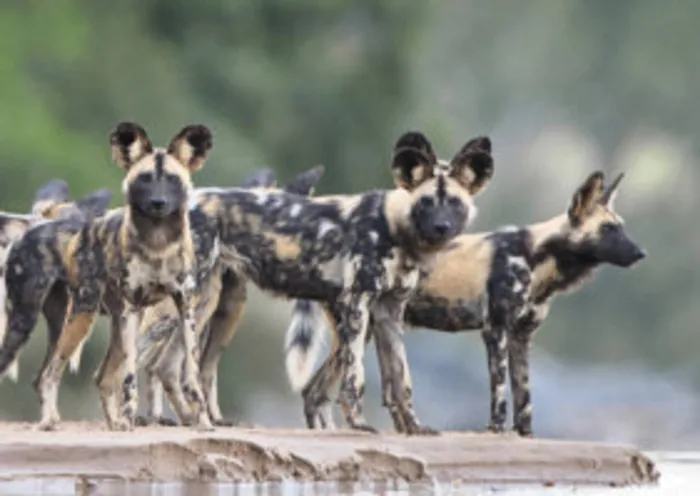On the trail of Africa’s wild dogs

Wild dogs on the hunt. Wild dogs on the hunt.
Pretoria - After nearly seven years keeping a close watch on the African wild dogs of KwaZulu-Natal, Brendan Whittington-Jones comes to the conclusion that only “the slightly insane” will ever take on the task of trying to protect South Africa’s rarest carnivore.
Yet, it was a period of his life that he is unlikely to forget.
It’s definitely something most of us office-bound types will not get to experience.
African wild dogs belong to a unique canine species that has survived for nearly 400 000 years.
But in just 50 years, they have become extinct in 25 countries.
And they are disappearing fast in other countries.
Throughout the continent, there are thought to be about 6 600 free-ranging African wild dogs left.
In South Africa, there are just 450 of these wild carnivores.
To put that number into some perspective, most of these dogs could fit into a single performance at either the Elizabeth Sneddon theatre or the Barnyard theatre in Durban.
The venues have 400 seats each.
Put another way, the entire free-ranging population of South African wild dogs could fit comfortably into six Putco commuter buses.
Little wonder then that organisations like the Endangered Wildlife Trust invest so much time and effort to ensure that these creatures do not go the way of the dodo and the passenger pigeon.
“Extinction is a nasty thing; it is an unfortunate and rather permanent arrangement,” says Whittington-Jones in his new book, which details his involvement as project co-ordinator for the Endangered Wildlife Trust’s African wild dog programme in KwaZulu-Natal.
For the first part of his stint, he was stationed at Mhlolokazane, a little square hut on the banks of the White Mfolozi River, inside the Hluhluwe-Imfolozi game park in KwaZulu-Natal.
Although it provided a roof over his head, there was little to commend Mhlolokazane to most urbanites. In fact, when his girlfriend, Farah, arrived at his new abode for a visit, she burst into tears, sobbing: “How do they expect you to live here?”
But the place grew on him, even though thirsty elephants would come to drink from the rain-fed water tanks next to his bedroom.
“I was actually just thrilled at the prospect of being able to live in iMfolozi Game Reserve.
“That has been the dream since I had completed a high school wilderness trail in the reserve many years earlier.”
Although there was plenty of time to appreciate the tranquillity of nature, he was there to work and write a Master’s thesis on the wild dogs.
During the next few years he would spend much of his day (and several nights) traversing the main roads and rutted back roads of Zululand, searching for evidence of wild dogs roaming between the remaining patchwork of wildlife reserves – or searching for new spaces where these much-maligned predators might be offered refuge by local landowners.
Space… That is what the wild dog really lacks in the human-dominated epoch that continues to engulf what is left of the old world.
In an attempt to work within this constricted land space, wild dog experts have devised a “meta-population” strategy that involves the regular, artificial movement of individual dogs from one reserve to another to avoid in-breeding.
But it doesn’t help that wild dogs still have a reputation of being “cruel and relentless” or “terrible brutes”.
Though they have to kill other animals to survive, Whittington-Jones says: “Their primary technique of disembowelling prey is a behaviour that is most offensive to our tender human sensibilities.
“It is the one stark characteristic that appears to lead people to abhor the species.
“Killing by claw and suffocation, or with several poorly placed shots from a high-powered rifle, is apparently more acceptable.”
Even Colonel James Stevenson-Hamilton, first ranger of the Kruger National Park, appeared to believe that any wild dogs should be shot on sight.
Almost 100 years later, some wildlife managers still seem to harbour misgivings about providing more space to the country’s most endangered predator.
One official, described as “Sierra Kilo”, gets several honourable mentions for his seemingly repeated attempts to stall the reintroduction of wild dogs into a large wildlife reserve in KwaZulu-Natal.
“We battled to eke out our little bit of conservation progress and attention in the swamp of concerns, politics and distractions swirling in the urban, concrete fortresses designated to serve conservation,” says Whittington-Jones.
“Unfortunately, it is becoming apparent that political manipulations and self-interest in the higher ranks of government conservation departments, further acidified by annual budget cuts, are demoralising committed and skilled conservation talent in these organisations,” he said.
This all sounds rather depressing, but his book is well worth the read.
Pretoria News